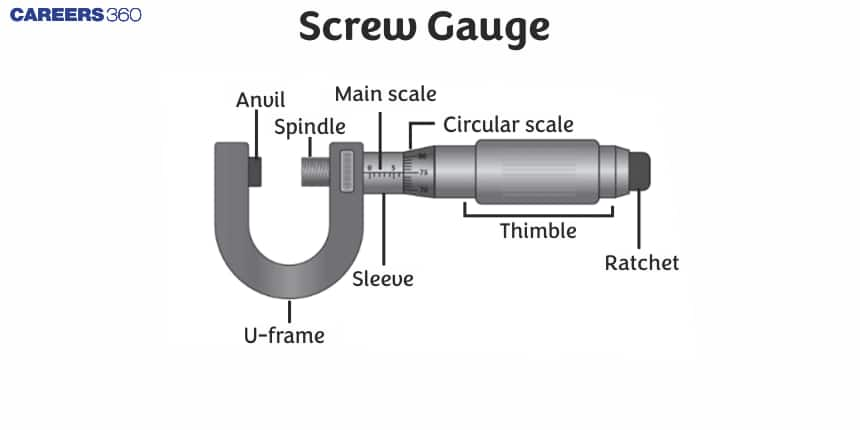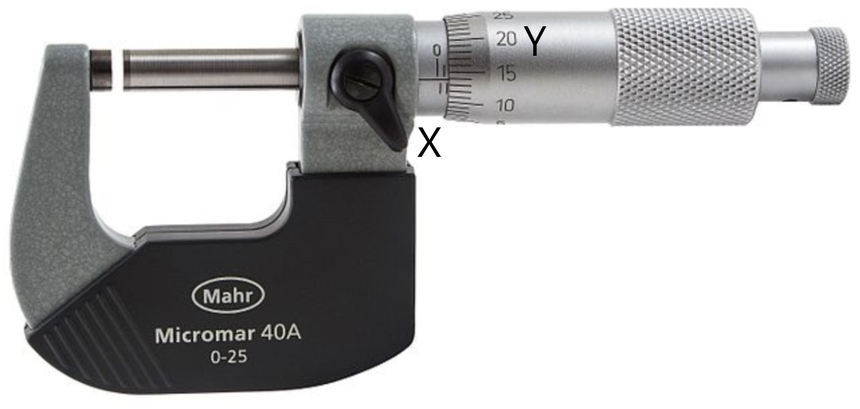Screw Gauge - Definition, Formula, FAQs
A screw gauge or a micrometer screw gauge is a precise measuring instrument for measuring extremely small lengths like thin wires' diameter or metal sheets thickness. It is U-shaped with a finely threaded screw that travels on turning transferring minute movements into readable measurements on a scale. A full rotation of the screw displaces it by a constant amount typically in millimetres, and readings are always the same. Screw gauges are extensively used in mechanical engineering, laboratories, and other precision industries where accuracy is very high. In contrast to a basic ruler or caliper, they yield much more accurate results. Learning its parts, formula, least count and measurement method is important for the students preparing for exams like IIT JEE Main and NEET.

Also read -
What is a Screw gauge?
A screw gauge is a precision instrument used to measure very small lengths, thicknesses, or diameters of wires and thin sheets with high accuracy. It works on the principle of a screw, where a small rotation of the screw causes a fine linear movement of the spindle.
It consists of a U-shaped frame, a screw, a pitch scale, a circular head (or thimble), and a ratchet for fine adjustment. The object to be measured is placed between the anvil and the spindle, and the reading is taken from the scales.

Components of Screw Gauge
The main components of a Screw Gauge are:
U-shaped Frame: It holds all the parts together and provides support to the instrument.
Anvil: A fixed metallic stud against which the object to be measured is placed.
Spindle: A movable screw that moves towards or away from the anvil when the thimble is rotated.
Sleeve (Main Scale): It is a stationary scale marked in millimetres and half millimetres.
Thimble (Circular Scale): A rotating part attached to the spindle with a circular scale divided into equal divisions.
Ratchet: It ensures uniform pressure is applied while measuring, preventing errors.
Lock Nut: Used to fix the spindle position after measurement for accurate reading.
Formula of Screw Gauge
The main formulas used in a screw gauge are as follows:
1. Pitch of Screw Gauge:
$
\text { Pitch }=\frac{\text { Distance moved by the screw }}{\text { Number of rotations of the thimble }}
$
It is usually expressed in mm.
2. Least Count (L.C.):
$
\text { Least Count }=\frac{\text { Pitch }}{\text { Number of divisions on the circular scale }}
$
The least count is the smallest measurement that can be read accurately with the instrument.
3. Total Reading (T.R.):
Total Reading $=$ Main Scale Reading + (Circular Scale Reading $\times$ Least Count)
4. Corrected Reading:
$
\text { Corrected Reading }=\text { Total Reading }- \text { Zero Error }
$
Working Principle of Screw Gauge
The working principle of a screw gauge is based on the principle of the screw — that is, the rotational motion of a screw is converted into linear motion. When the thimble of the screw gauge is rotated, the screw (spindle) moves forward or backwards through a fixed distance depending on the pitch of the screw. This small and precise movement allows us to measure very tiny dimensions like the diameter or thickness of a wire or sheet. The distance moved by the screw per rotation is known as the pitch, and the smallest measurable distance depends on the least count of the instrument.
Uses of a Screw Gauge :
The screw gauge is a precision instrument used for measuring very small lengths, thicknesses, or diameters of objects that cannot be measured accurately with a ordinary ruler. Its uses are as follows:
- Measuring Small Lengths: It is used to measure extremely small lengths with high accuracy, typically up to 0.01 mm.
- Diameter of Thin Wires: It is commonly employed to determine the diameter of thin wires, threads, or filaments in laboratories and engineering applications.
- Thickness of Sheets: The screw gauge can measure the thickness of thin metallic, plastic, or paper sheets.
- Measurement of Small Spherical or Cylindrical Objects: It is useful for measuring the diameters of small spheres, ball bearings, or cylindrical rods.
- Precision Engineering Applications: In mechanical and manufacturing processes, screw gauges are used to measure small machine parts where accuracy is essential.
- Scientific Experiments: In physics experiments, it helps in determining dimensions precisely for calculations involving volume, density, or surface area.
Solved Examples of Screw Gauge
Example 1:
Problem: The pitch of a screw gauge is 1 mm , and it has 100 divisions on its circular scale. If the circular scale reading (C.S.R.) for a wire is $\mathbf{4 5}$ divisions, find the diameter of the wire.
Solution:
Given:
Pitch = 1 mm, $\mathrm{N}=100$ divisions, C.S.R. $=45$ divisions
$
\text { Least Count }=\frac{\text { Pitch }}{\text { Number of divisions on circular scale }}=\frac{1}{100}=0.01 \mathrm{~mm}
$
$
\text { Diameter }=\text { C.S.R. } \times \text { L.C. }=45 \times 0.01=0.45 \mathrm{~mm}
$
Answer: Diameter of the wire $=0.45 \mathrm{~mm}$
Also, check-
- NCERT Exemplar Class 11th Physics Solutions
- NCERT Exemplar Class 12th Physics Solutions
- NCERT Exemplar Solutions for All Subjects
NCERT Physics Notes:
Related Topics,
Frequently Asked Questions (FAQs)
The formula for calculating the minimum screw gauge is as follows:
Minimum screw gauge = (Pitch of screw gauge of screw gauge) / (total number of stages)
Minimum calculation of micrometer screw gauge = (1 mm) / (100) = 0.01 mm.
Zero Screw gauge Error:
When the surface of the screw plane and the plane of the plane different from the frame are touched, if the zero of the head scale meets the axis of the pitch of screw gauge scale, there is no zero error.
Solution: The distance travelled by the line scale when the circular scale makes the full rotation p = 1mm p = 1 m m (tone). The value of a split on a circular scale is N = 100. Therefore, one partition on a circular scale is LC = p / N = 1/100 = 0.01mm LC = p / N = 1/100 = 0.01 m m.
The screw gauge works on the travel principle. When the screw is rotated, there is a direct movement on the large scale of the screw gauge. This scale is used to calculate the minimum length. The distance travelled by the rotating cable for each rotation is known as the pitch of screw gauge
The smallest Vernier scale calculation is calculated using the following formula, Minimal calculation = Very small reading on the large scale Verseer scale scale Vernier = 1mm10 = This is the smallest number of Vernier Callipers. Therefore, the micrometer least count for Vernier Callipers is 0.1mm.
There are two types of zero errors - wrong error and positive error
The following are four common types of micrometer screw gauge and 3 types of special micrometer targets.